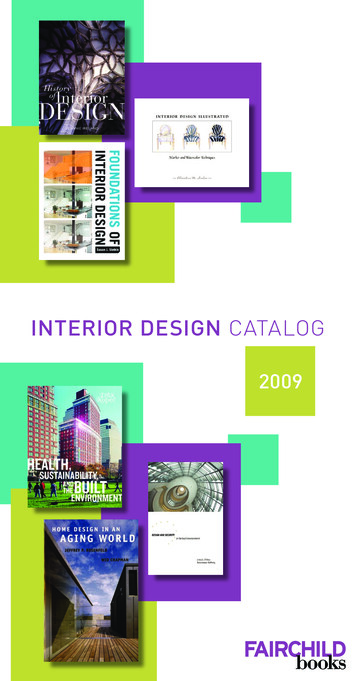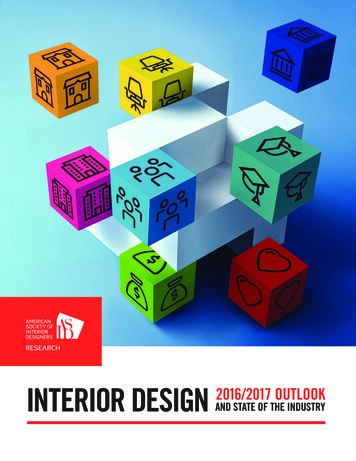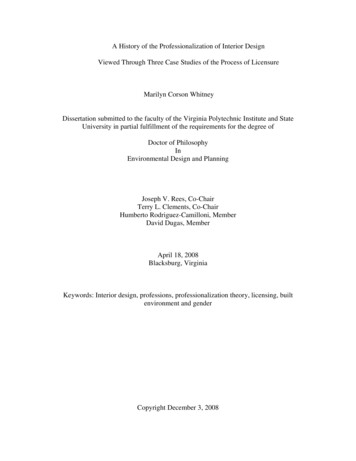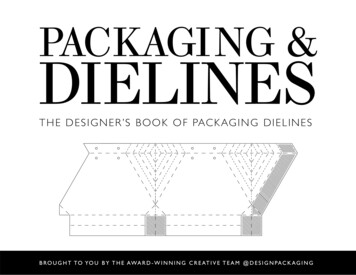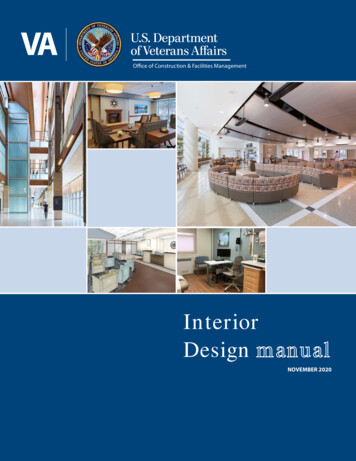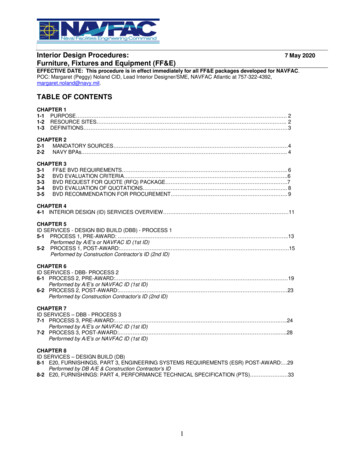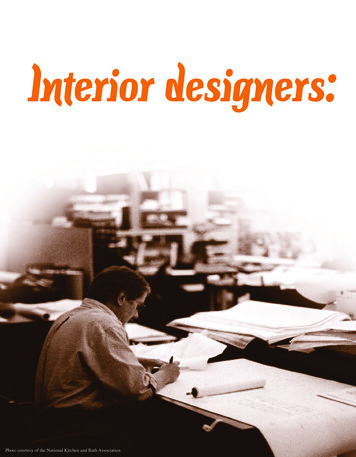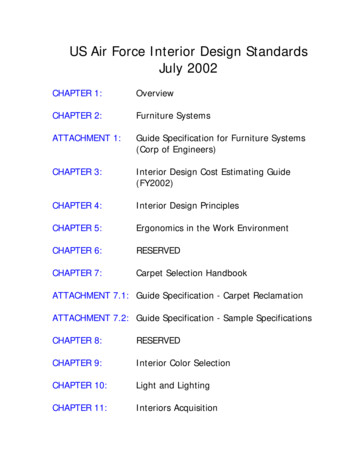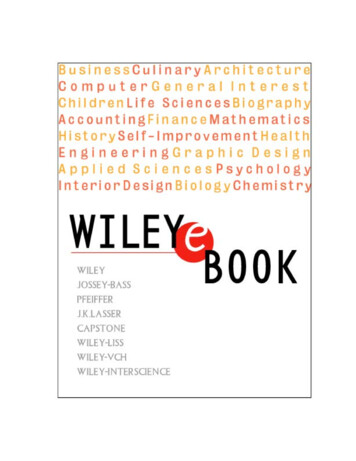
Transcription
THE INTERIOR DESIGNBUSINESS HANDBOOK
THE INTERIOR DESIGNBUSINESS HANDBOOKA Complete Guide To ProfitabilityThird EditionMary V. Knackstedt, FASID, FIIDAJOHN WILEY & SONS, INC.
䊊This book is printed on acid-free paper. Copyright 2002 by Mary V. Knackstedt. All rights reserved.Published by John Wiley & Sons, Inc., New York.Published simultaneously in Canada.No part of this publication may be reproduced, stored in a retrieval system or transmitted in anyform or by any means, electronic, mechanical, photocopying, recording, scanning or otherwise,except as permitted under Sections 107 or 108 of the 1976 United States Copyright Act, withouteither the prior written permission of the Publisher, or authorization through payment of theappropriate per-copy fee to the Copyright Clearance Center, 222 Rosewood Drive, Danvers, MA01923, (978) 750-8400, fax (978) 750-4744. Requests to the Publisher for permission should beaddressed to the Permissions Department, John Wiley & Sons, Inc., 605 Third Avenue, New York,NY 10158-0012, (212) 850-6011, fax (212) 850-6008, E-Mail: PERMREQ @ WILEY.COM.This publication is designed to provide accurate and authoritative information in regard to thesubject matter covered. It is sold with the understanding that the publisher is not engaged inrendering professional services. If professional advice or other expert assistance is required, theservices of a competent professional person should be sought.Library of Congress Cataloging-in-Publication Data:Knackstedt, Mary V.Interior design business handbook : a complete guide to profitability / Mary V.Knackstedt, with Laura J. Haney.— 3rd ed.p. cm.Includes bibliographical references and index.ISBN 0-471-41232-5 (cloth: alk. paper)1. Interior decoration firms—United States—Management—Handbooks, manuals, etc.Interior decoration—United States—Marketing—Handbooks, manuals, etc. I. Haney,Laura J. II. Title.NK2002 .K57 2001729 .068—dc212001026894Printed in the United States of America.10987652.4321
This book is dedicated to designers, especially to those whocall me with questions or to share information.Together, we can continue to raise the standards for the field ofinterior design and to increase our ability to serve our clients.
ContentsChapter 1Chapter 2Chapter 3Chapter 4Chapter 5Chapter 6Chapter 7Chapter 8Chapter 9Chapter 10Chapter 11Chapter 12PrefaceixAcknowledgmentsxiiiFinding Your Place In Interior Design1Starting a Business29Planning For Profit and Growth51Setting Up a Design Studio63Developing a Team of Staff and Consultants79Marketing and Selling117Succeeding in Project Management191Charging For Your Services217Working With Sources and Contractors241Managing Your Office271Mastering Financial Management315Growing as a Professional371Recommended Reading377Design Schools385Index387vii
PrefaceWhen we use the right procedures, the business portion of our organization canbeautifully complement the creative process. As interior designers, we deal withbusiness issues every day. We engage in business development when we seeknew clients. We deal with finance every time we handle money. We sign contractsand letters of agreement, address personnel problems, and seek out new resources. We cope with masses of paperwork, including writing specifications andplacing orders. Often we do these tasks without the background and advisorsavailable to many other kinds of professionals.To stay in business, we have to understand business. We don’t have to earnbusiness degrees or be personally capable of performing every business function,from accounting to devising retirement plans, but we do have to be able to talkwith and understand the people who are specialists in these fields. To pull ourweight as members of financial planning teams and to help our firms end theyear with a profit, we cannot afford to wear blinders to financial matters.Though business procedures are taught in design schools, they are not taughtas extensively as they should be; the courses are usually scheduled for one semester or a year. Business procedures are the basis of communication that wewill use throughout our professional years. We must relate to other industries,including the financial and legal entities that are part of the business world. Ifhandled properly, these relationships can ease and complement our own workpractices. Moreover, a good basic understanding of specific business functions isnecessary for everyone, not just the person running the design company. Staffmembers or anyone participating in the company, no matter in what capacity,will benefit from a good understanding of business practices.Other professions establish strong liaison and group activities through whichthey share their business practices and solutions to common problems. The interior design profession needs to do the same. We can learn from each other; andby learning from each other, we can strengthen our individual firms and createa stronger and better-understood profession.Awareness is the key. Just as we continue to learn about design throughout ourlifetime, we need to keep current with other issues that affect the interior designfield. Everything that affects business in general affects the interior design business. When insurance rates go up, or certain types of insurance become unavailable, we may have to modify the way we do business. The state of the stockmarket, the price of oil, and the value of real estate affects our clients’ attitudesto buying design services; therefore, they affect our interior design businesses.ix
x䊏Interior Design Business HandbookIt’s a chain reaction: If we are not operating our firms profitably, we all lose—ourclients, because we don’t have the same quality of interest in a job that is losingmoney; our staff and resources, because we don’t have the funds to promptlymeet our obligations. Consequently, we may not be able to attract the caliber ofprojects we enjoy working on and find most financially profitable.When designers are comfortable dealing with money and with all the financial issues of our business, it gives us a tremendous sense of freedom and provides a good environment for creativity.The Interior Design Business Handbook is written primarily for practicing interior designers—whether working independently or within large firms. It coversthe full range of business activities and procedures for the life of a practice—fromchoosing a location and running a business on a daily basis to selling it when it’stime to retire. It is also useful to students and as a training manual for supportstaff members. It defines business procedures that work for interior design firmsall over the country. It’s a book to refer to just before a meeting with businessadvisors. You may also want to give a copy to your bookkeeper or accountant sothey better understand our field.This third edition of the Interior Design Business Handbook addresses manynew issues not included in previous editions. My first book, Interior Design forProfit was a very simple text. Since then, however, our work has become morecomplex, and each edition of the book was progressively more extensive. Still, Iwas surprised at the number of changes that needed to be made in this edition.Banking, other financial issues, and many general procedures have changed significantly. Technology has been part of that change. We are also dealing more onan international basis. Even as I finish this book, I realize that I would like tokeep going, as there are so many more subjects that I would like to present.But if I included everything I would like, the book would be so large it would bedifficult to carry. Thus, it became necessary to address only the most importantissues.This book provides the basics to help you formulate an excellent businessfoundation for your design firm. The information contained within has been researched and gathered in a very real, “hands-on” fashion. During the manyworkshops, programs, and classes in which I have held with designers, architects, and others in related industries. At these meetings, many new questionssurfaced. If I did not have a solution to them, I asked my consultants for their assistance in finding one. Once we found a solution, we asked the designer to trythe procedure. If appropriate, we tested the procedure in our firm. After the procedure had been tried in a number of firms, and polished, it was then presentedin workshops that become the basis of articles or books. As a result, I can statewith confidence that every procedure in this book works. They are used daily inmy own firm and other successful design firms throughout the United States.The goal of this book is to define business processes that complement the profession of interior design. I believe that we have a great contribution to make inour world. The creative process is very valuable in problem-solving situations.This book uses the design process to present and solve many of our business issues. You will find these procedures quite conducive to your creative style.In working with many interior design firms, some near bankruptcy, othersamong the most profitable firm in the country, I have found that they have veryspecific problems. I’ve seen what goes wrong; even the most talented designerscan lose money. But there are very easy ways of accomplishing our goals, andyou will find many of those procedures here.
Preface䊏xiIt is my hope that the Interior Design Business Handbook will enhance yourcreative energies by making the business end of interior design not only comprehensible but also rewarding—in every sense of the word.Interior design and architecture at one time were considered “gentlemen’s professions,” something they did because they loved doing it, not because they hada need for or interest in earning money. Today, however, though most of us stilllove our work, we need to support ourselves and our families. To do that, we needthe right business structure, one that permits us to be creative, to service ourclients, and to earn appropriate income.
AcknowledgmentsMy goals in writing this book and in sharing business information have been tohelp create a professional standard for the interior design field and to try to ensure that there are rewards enough to keep all the bright and talented designersworking in this field. Without the help and encouragement of many special people, I could never have completed a book of this scope and complexity.Special thanks to the late Samuel Ledger for teaching me to understand accounting procedures. To Laura J. Haney for teaching me to write, and developing and refiningthe earlier editions. To John Purcell, Jr., for updating legal information. To Shirley Y. Rouzer and Robert Rutz of the PNC bank for updating me asto current banking practices. To Linda Chubb for assistance on a multitude of forms. To Carmelia Urich for typing the several reams of paper used in writingand revising the manuscript. To Lee Kolker for all her encouragement. To all my designer friends and fellow members of ASID, IIDA, IDS, andIFDA for posing questions that inspired research, and for sharing theirviews on a variety of issues. To the consultants and business friends who helped develop ways toimprove professional business practices for designers, and who are partof the Design Business Solution team. To my support staff who helped me live, run a business, and write a bookat the same time: And to my friends, who thought I had deserted them.xiii
1Finding Your Place inInterior DesignInterior design is a profession, a career, a vocation, and a lifestyle. It is not justa job. To practice it successfully, it is important to have a clear idea of what interior design involves, as well as an appreciation of its demands. It is just as important to know whether you have the combination of personal attributes and interests that a professional interior designer needs.WHAT IT TAKES TO BE AN INTERIOR DESIGNERDesign expertise comes from exposure and experience, a combination of academic study and learning on the job. Every one of your experiences contributesto your design vocabulary. Design education stresses problem-solving. The fourto six years you spend in the formal study of interior design gives you the informational tools to use in your work—problem-solving skills being perhaps themost valuable tool of all. But interior design demands a tremendous amount ofongoing research. To be a responsible designer, you must study new technologies, new product specifications, new laws and regulations, and changes in building and fire codes. With each new project, there is more to study and learn. Youreducation never ends. Learning is part of the lifestyle.Interior design work, by nature, requires that those who practice it learn totemper their innate idealism with the practical demands of reality. You design forreal people in the real world. In every design project you undertake, you must bewilling to strike a balance between what you envision as “the ideal” and whatyou can achieve within the project’s practical constraints.Interior design is creative work, and it attracts talented, creative people. In fact,without talent, you cannot go far in this field. Your challenge is to direct and focus your creativity. There is no problem in coming up with new ideas—only inchoosing which ones should be executed first, which ones have priority. Settingand acting on priorities requires mental and behavioral discipline.The days of sitting at a drafting table and drawing pretty pictures are over—ifthey ever existed. Designers have to make things happen. Social contacts are important in acquiring new projects. You need to like people and you need to getalong with all kinds of people and to inspire their confidence.An interior design career depends on organization. From beginning toend, every project involves myriad details; keeping on top of things is absolutely
2䊏Interior Design Business HandbookA Personal Inventory for ProspectiveInterior Designers1.2.3.4.5.6.7.8.9.10.11.How important is interior design to me?What kind of lifestyle do I want to have?Do I have the innate creative abilities to become a successful designer?Am I willing to spend the time and money required for the formal training?How much time do I want to devote to my work?In general, do I like the people in the field enough to work with them?Do I have the personality to work with any kind of client?Do I enjoy planning and organizing?Am I self-disciplined?Am I self-motivated?Do I have more than average physical and emotional stamina?critical. Even if your firm includes someone whose job is to expedite, you will always have to deal with mountains of details.Interior design demands high energy and passion. It is almost never a nine-tofive business; on occasion, it is a twenty-four-hour-a-day profession. Interior designers need physical and emotional stamina to fuel their long hours and to copewith pressures of completing a job on schedule and to their client’s satisfaction.Most extremely successful designers—those with annual personal incomes of 200,000 to millions per year—are addicted to interior design. They live it, eat it,and sleep it. It is a passion they cannot live without. Design addiction can be destructive. But the most successful designers are people who have managed tomerge good business practices with their positive addiction.This book is about how you can integrate your love for the creative parts of interior design—and the way of life that comes with your career—with good businesspractices. It is about success with profitability.FIVE TRADITIONAL DESIGNER-CLIENT RELATIONSHIPSThe designer may fill many different roles in his or her relationship with theclient; the business structure established will reflect the roles accordingly. Traditional roles that designers have held in the past include pure designer, agent, merchant, employee, and contractor.Pure DesignerIn this capacity, the interior designer provides just professional design services:drawings, documents, and purchasing specifications for all interior elements andfurnishings required. The scope of the work usually includes the preparation ofthe entire interior plan.
Finding Your Place in Interior Design䊏3AgentThe designer can act as an agent on the client’s behalf, placing the client’s orderswith manufacturers and showrooms. The monies go through the designer’s firmor under his or her name. The designer is responsible for managing the project.In some cases, the contracts are written so the designer does not assume responsibility for the merchandise, materials, and the work performed.MerchantThe designer becomes a merchant when selling merchandise. Many design firmswill procure and sell merchandise. In some smaller communities, there is nochoice but to act as a source of materials and to see that they are appropriately installed. The design firm may also charge a fee for the design of the space.EmployeeSome designers are employed by retail stores, where they are usually paid salaryplus commission. When the client purchases items from that store, the designer’sservices can be included or can be offered at an extra fee. More and more often,firms of this type are charging some fee in addition to the retail or list price ofitems, depending on the individual financial structure of the company and itslocation.ContractorThe designer may act as a contractor by employing the workers required to do construction, hang paper, finish surfaces, handle drapery and window treatments, andso on. In some states, the designer will have to carry a contractor’s license in order to provide these services. In many instances, the craftspeople are directly employed by the design firm; in others, they work on a freelance or contracted basis.WORKING STYLESMany of the arts attract people who like to work alone; but interior design forcespeople to work together. This makes interior design almost as much a social science as an art.Interior design touches many other disciplines. There is constant interactionwith all types of construction trades, as well as with artisans from many differentcraft groups. A coordinated effort is of primary concern.Working AloneIf you work as an independent designer, you can do whatever you want at whatever speed you choose. If you want to work only one day a week, you can. If yourforte is specialized work that no one else wants to become involved with, perhapsyou need to work alone. If you are certain that you have mastered your art tothe point at which you can perform every task within your specialty, and have a
4䊏Interior Design Business Handbookpersonality that does not require a lot of stimulation, then an independent practiceis for you.TeamworkThe trend now is to work in groups, or teams. Designers who practice in groupsdo so because they see this as a better way to accomplish their goals. It is a growing movement. The group may not be part of a corporate structure, where a groupof designers all work for the same firm, but design teams and design partnershipsare working successfully now, and there will be more of them in the future.Interior designers are also realizing that by working together, as attorneys andphysicians often do, they can share a business manager, an expediter, an accountant, an insurance consultant, legal services, and other professional managementpersonnel. This gives them a better-managed and more profitable firm, with opportunities for better retirement plans and many of the perks that are possible onlyin a team arrangement.When designers work with other designers, there is a chance to test each other’sdesigns, to determine what will work. When three other people look at a designand all say “I don’t see any problems,” obviously the chance of producing it successfully is much greater than if done in isolation. This kind of trial process, I havefound, is important to quality design.Increasingly, clients want one firm to control the whole project, even thoughtheir project may be complex enough to require several disciplines. Therefore,they like to hire firms who do it all. Obviously, a designer can team with other design professionals. Multidiscipline design teams of architects, landscape architects,interior designers, and engineers have an advantage in bidding for larger projects.Clients usually prefer teams that have experience in working together.Government regulations require more recordkeeping than ever before. The natureof the work has changed, and clients are more likely to sue if the unforeseen occurs.We need to become more professionally efficient and to develop high administrativeand production standards. We need access to more sophisticated tools, such as computerized equipment. A small office cannot as afford much of it. But by working together, designers can afford this kind of equipment and get the bonuses of other designers’ professional knowledge and the stimulation of each other’s company.At one time, designers would work together in order to share technology. Today,computers are so inexpensive that it is easy for each professional to have his orher own computer, or even several.Technology also permits designers to work where they want to work. It may beat home, in the mountains, at the beach, or any other locations where you feel mostcreative. Technology permits us to communicate, to share projects or administrativeneeds with others in any part of the country. I often work with specialists in otherstates, yet we work so closely that you would think we’re in same office. Technologyis a great research tool and a wonderful storage system, but more importantly, it enables us to work with people who otherwise would be too far away to work with.We can now design our companies to suit the type of work that we are doing. Technology permits us to grow, and the opportunities are increasing constantly.Design AssociateAt one time, people became design associates because they didn’t have funding orwere not ready to start their own company. Today, many interior designers who
Finding Your Place in Interior Design䊏5have been practicing independently are associating with larger firms because theprofitability is so much greater. Some interesting arrangements share profits between the management company and the associate designer. In this way the associate is responsible for writing the orders for handling all the design issues. Insome instances, the designers provide their own marketing and bring in their ownjobs; in other cases, the jobs are brought in by the firm.Designers can work as hard as they want to. If the work or project is highly profitable, they profit accordingly. If they elect to do a project for little markup, perhaps as a marketing effort, this is also acceptable. Of course, certain overhead requirements must be met. If the designer decides to take time off—for example, tostudy—this is his or her decision since he or she is only paid for performance.Experienced designers have found this arrangement one of the most profitableand most pleasurable ways to work. Let someone else handle the business problems.Designers want to design. Also, the clients know there is a higher power, so they areless likely to question pricing, billing, and other contract issues. In addition to highquality management, the larger company atmosphere can also provide designerswith the tools that they could not afford on their own—high-tech environment, library, consultants, support staff, communication with other designers, and so forth.The arrangement permits the designer to work as an independent contractor.Designers cover all of their own expenses and are responsible for their own design work, but the managing company handles the actual processing of the project. The gross profits are usually split at different levels, depending on the variedresponsibilities and levels of performance.Today, we can arrange to work on the projects and parts of projects that use ourbest talents. There’s no point in designers spending 75 to 90 percent of their daydoing tasks that they are not good at. Even when you practice alone, you don’t haveto do it all. You can have the best bookkeeper, the best specification writer, and thebest lighting designer. You can build a team of professionals you can call on, anduse software programs they suggest. Whatever you need, it’s there.SPECIALIZATION AND SPECIALTIESThis is definitely a time for specialization. Designers with the greatest name recognition and financial success are those who have specialized. (This could lead youto wonder if being multifaceted in accomplishments and abilities does not hurtmore than it helps.)A review of design publications of the past ten years shows that less-qualifieddesign firms can and did take the market share from “better” firms just becausethey were very clear in stating that they do offices, or that they do nothing but medical facilities, or that they do only restaurants.Specialization most often leads to better profit. Specialists know their work; it iseasier to do it because they did it last week. If you choose to specialize, you canvary certain facets of the work, but you do not have to relearn 80 percent of thetechnology to lower the risk of error and speed up design production.Interior design has been a broad-based service profession—blanketing residential, contract, and industrial work. In the next decade, however, interior design willbe more specialized than it has been, and some of the best and most interestingjobs will probably be in the specialties. The following pages offer brief looks atover one hundred areas of specialization.
6䊏Interior Design Business HandbookClient demand can cause you to change your area of expertise. A designer inOhio specialized in education interiors. In time, she found that although shehad become a specialist and did some of the most up-to-date and innovativedesigns for education, the demand was no longer there. She was forced tochange her orientation, and began designing psychological/psychiatric spaces,working with many therapists to develop spaces to support their therapies.When interest in this dwindled, she found herself specializing in interiors thatsupported profit-making endeavors—professional services, manufacturing,general business, and spaces with a marketing and/or production component.In each instance, she was able to use some of what she had learned in theprevious specialty. Still, she had to study, bring in many consultants, and doa lot of traveling to meet with other specialists in the course of mastering newspecialties.Changes are expensive, but often the best thing that can happen to creativepeople. Creative people become bored; boredom is one of their greatest problems, so having a specialty developed out of another specialty is really themost productive and profitable way of making a change.Acoustic DesignHearing is one of the five senses; sound is an integral part of every environment.As space becomes more expensive and people live and work closer together, quiethas become a luxury. Specialists in acoustic design consult on projects rangingfrom concert halls, conference rooms, open offices, and restaurants to residentialdesign. Controlling sound has become a science. In open landscape offices, thereare sound-breaking panels and sound maskers. Teleconferencing rooms need thesound to be contained. On the other hand, restaurants need a certain amount ofnoise in order to sell food. In any space, from residential to the most technologically demanding commercial environments, there are sounds we want to hear andsounds we don’t want to hear.Administrative HeadquartersEvery major company has an administration building with needs and demandsthat require design. The demands change as the products change, and interior designers are called in to streamline and to develop spaces to support work flow. Atone time, we just designed offices, but today social environments are also important. Sometimes, more important decisions are made over a cup of coffee than inthe boardroom.Adaptive ReuseReusing old buildings for new purposes is a growing trend as the composition ofcities changes. Factory lofts are converted into shopping malls and residential use.It is not always practical to maintain an older commercial structure as commercial real estate. For example, turning the Chrysler Building into a residential con-
Finding Your Place in Interior Design䊏7dominium building is being seriously considered. The building’s construction willnot accommodate the way computers are used today in business. Workstations canonly be functional within so many feet of the main terminal. This makes manymajor landmark buildings obsolete as office space, while their location and thequality of construction argue that the building should be reused. This ties in to aconcern for ecology and for not wasting available resources.Airplane DesignThis is a unique specialty. Airplanes range from a standard passenger carrier to aflying conference room or living space. Designers must consider design elementsin terms of weight, fire safety, and psychological and environmental effects.Amusement Park DesignSome designers work on theme parks, developing the visual components that enhance rides and exhibits. These can incorporate animated figures, and appeal toall the senses, even that of smell. These designers may develop unique signage forthe park, design the fixtures, or be involved with the service areas: foodservice,restrooms, souvenir shops. Park design has this in common with museums andcommunity buildings. Safety, effectiveness, and efficiency are important. Profitability is determined by the effectiveness of the fantasy, and everything has towork so that the fantasy is maintained. Designing traffic patterns to keep peoplemoving is an art in itself.Apartment/Condominium/Co-op DesignWith more multiple-housing developments in every part of the country, this specialty
Interior Design Interior design is a profession, a career, a vocation, and a lifestyle. It is not just a job. To practice it successfully, it is important to have a clear idea of what in-terior design involves, as well as an appreciation of its demands. It is just as im-File Size: 2MB


